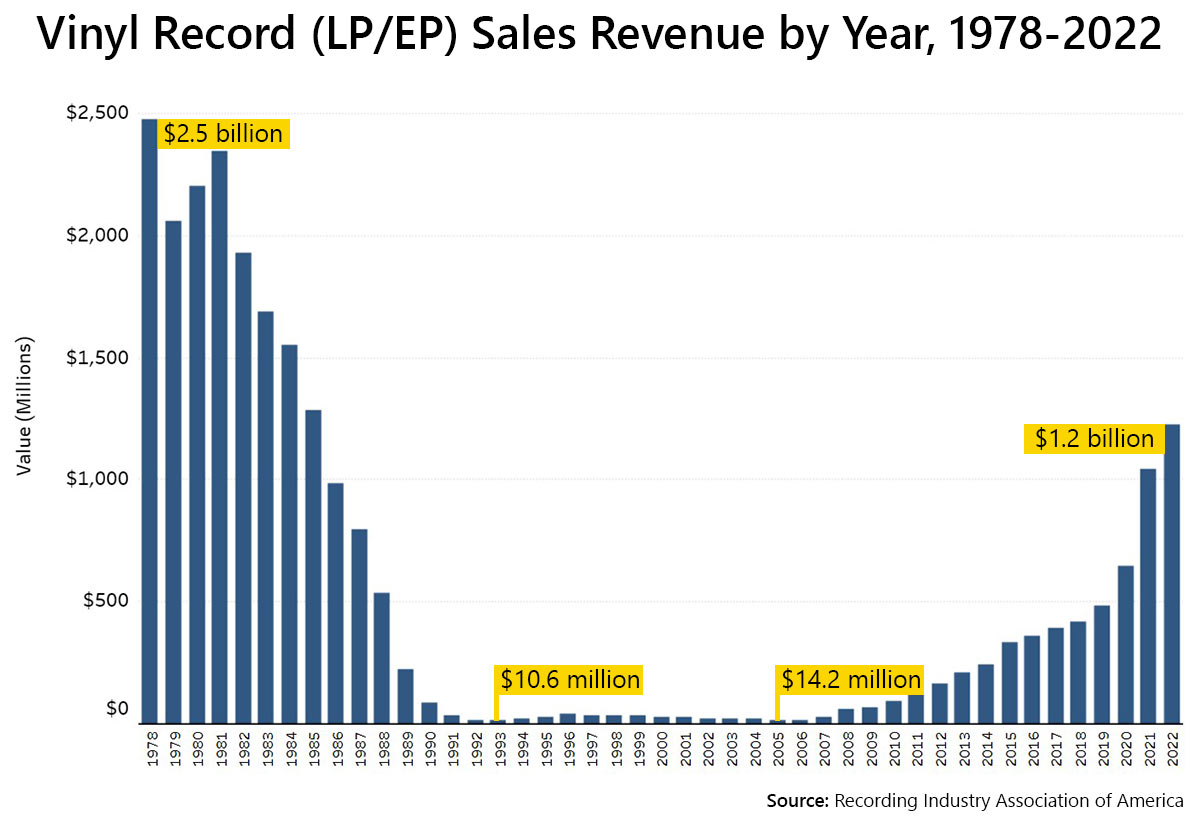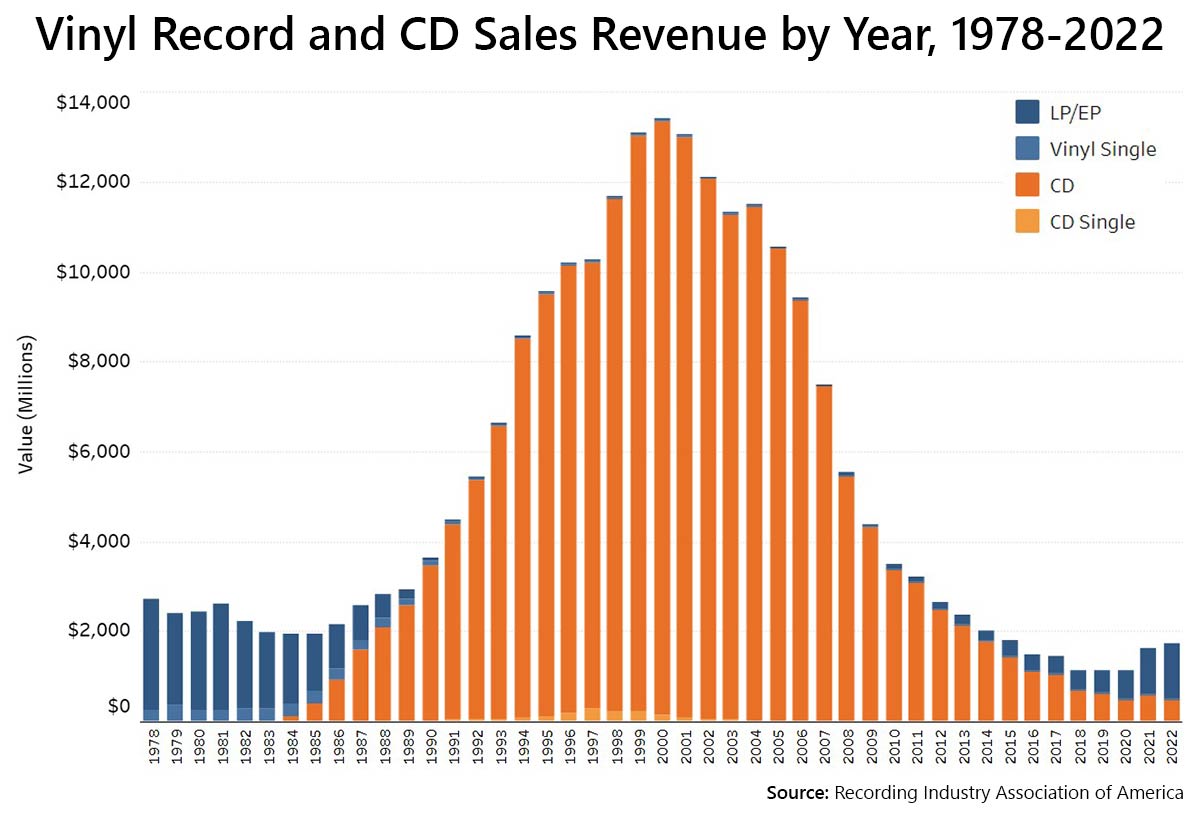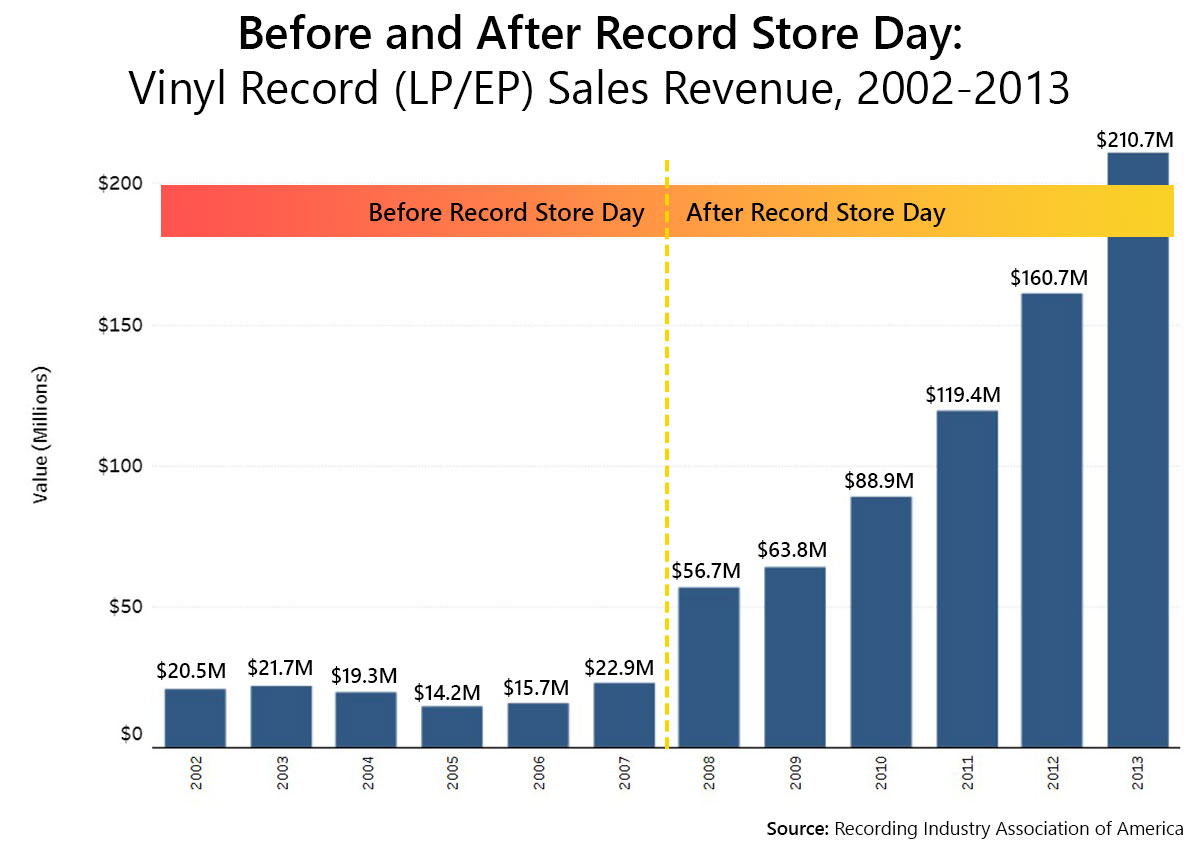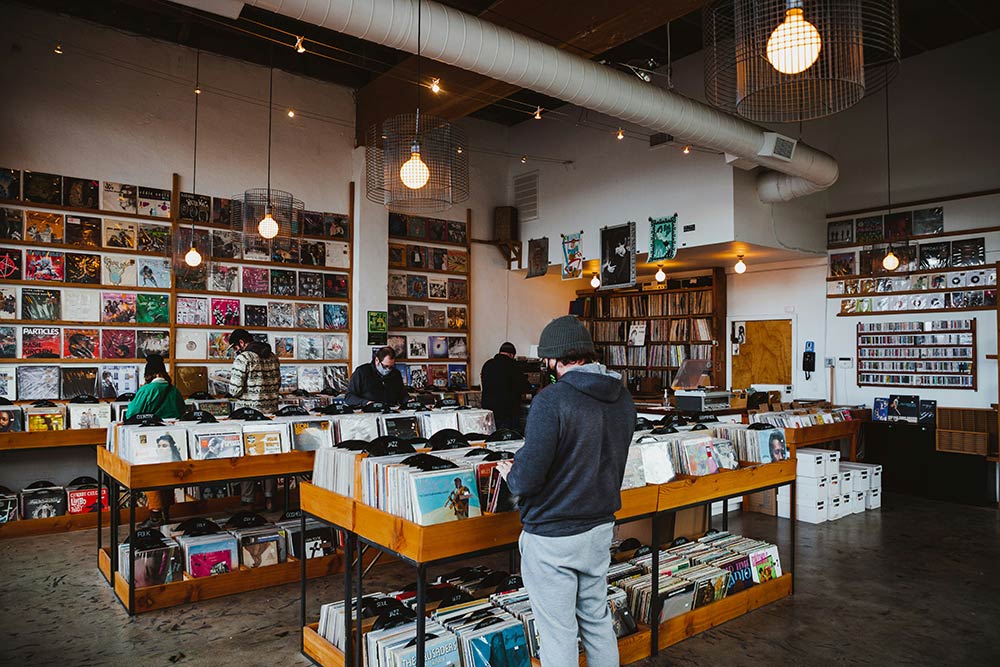- Navigator
- Industry Analytics and Strategy
- Manufacturing
- Retail, Services, and Accommodations
For most of the 20th century, vinyl records reigned supreme as the only widely available music format in the US. But that all changed with the introduction of new recorded music formats, each one more formidable than the last.
First came 8-track and compact cassette tapes in the early 1970s and 1980s that were cheaper, smaller, and could be played in your car, which was a game-changer for many music fans (some automobile manufacturers briefly offered record players in their cars in the 1950s and ‘60s with limited success).
Next came compact discs (CDs) in the late 1980s, which were smaller than cassettes or records, allowed you to skip immediately to your favorite songs, and even initially claimed to be indestructible (a claim that was subsequently debunked).
By the time digital streaming and downloading were introduced in 2004, the vinyl record format was a shadow of its former self, representing a mere 0.2% of the total sales revenue across all recorded music formats that year.
However, starting in 2007, something remarkable happened: Vinyl record sales started increasing year over year, a trend that still shows no signs of stopping. Defying the odds and surprising many in the music industry, including manufacturers (more about that later), vinyl records are experiencing an unexpected renaissance in the digital age.
In 2022, vinyl records officially surpassed CDs as the most popular physical recorded music format for the first time since 1987 (41.3 million units sold vs. 33.4 million units for CDs).
In the first half of 2023, vinyl records brought in 72% of all non-digital recorded music format revenues in the US, surpassing CDs by a wide margin ($632.4 million vs. $236 million).
What is Driving the Vinyl Records Revival?
1 | Record Store Day
Record Store Day was launched in 2008 to celebrate and promote the unique culture of independent record stores in the US. As part of the annual event, limited numbers of special vinyl and CD releases are made available exclusively at participating record stores. The event was so successful that it is likely the primary cause of the 147% increase in total US vinyl record sales that occurred that same year. The event has expanded significantly since 2008 and although it has faced some criticism over the years, it remains a big driver of the new vinyl renaissance.
2 | The Pandemic
In 2021, vinyl records enjoyed a 68% increase in total sales volume and a 55% increase in total sales revenue over 2020 in the US, reaching $1 billion in sales for the first time since 1985. This jump was likely driven by an increased interest in record collecting that occurred during the COVID-19 pandemic as people looked for new hobbies to keep them occupied during lockdowns and quarantines.
3 | Nostalgia
American culture has a long history of rediscovering and being inspired by the trends and styles popular during previous decades. A prime example of this is the 1950s revival movement during the 1970s which spawned TV shows like “Happy Days” and “Laverne & Shirley,” movies like “American Graffiti” and “Grease,” and musical acts like Sha Na Na.
In the 2000s, the 1970s and 1980s experienced a cultural revival, which inevitably led to a renewed interest in music from those decades, most of which was released primarily on vinyl.
4 | Digital Burnout
Some people have fallen out of love with the high-tech gadgets that are the hallmarks of our modern times. They are opting to trade in their smartphones, digital streaming services, and Bluetooth stereos for lower-tech options like flip phones or (gasp!) landlines, film or fully manual digital cameras, portable personal CD and cassette players, and (you guessed it) record players.
5 | Collectability
Many people’s record collections are worth quite a lot of money and are something they take great pride in. A large number of records, both old and new and across all genres, are considered collector’s items and are hard to find in the wild (e.g., thrift stores, independent record stores, garage sales, and online). The thrill collectors get when they find one of these rarities in good condition at a decent price is addictive.
> Find out the estimated value of your records on Discogs
6 | Aesthetics
When you ask them why they love vinyl records, most collectors will wax poetic about a wide variety of sensory delights, including:
- They sound wonderful and many enthusiasts will tell you that sound is superior to CDs or digital recordings (any pops and crackles just add more warmth).
- Old records smell amazing (like old books with a hint of PVC) and some record-pressing plants can actually infuse the vinyl with different scents. Early examples of this included Stevie Wonder’s “Journey Through the Secret Life of Plants” album (1979), which had an earthy, floral scent, and early pressings of Madonna’s “Like a Prayer” album (1989), which smelled of frankincense and patchouli.
- Album covers and even the vinyl itself are considered to be works of art that in many cases were designed, photographed, or created by well-known artists and graphic designers.
- The sometimes-lengthy liner notes, thank-you lists, and song lyric sheets provide fascinating behind-the-scenes stories and tantalizing glimpses into the creative processes of your favorite bands.
- Some records contain special gifts for fans, like posters, stickers, and calendars.


Examples of record covers and colored vinyl beloved by the author (from her own collection).
The Economic Impact of the Vinyl Records Renaissance
There have been several notable impacts resulting from the reinvigorated vinyl record market, both for small businesses and for manufacturers.
Independent Record Stores Flourish
Most large corporate record stores like Tower Records, Camelot Music, Sam Goody, and others either closed most of their stores or went completely out of business in the 1990s and early 2000s. This left only the small, independently owned record stores to carry the vinyl torch.
Now, renewed interest in vinyl has breathed new life into these independent record stores, turning them once again into vital community hubs for music culture. Existing independent record stores that sometimes struggled to stay open during the rise of digital music are now thriving and new stores open every day in cities across the nation. Many of these stores offer a curated selection of vinyl records, CDs, and even cassettes, and some like to focus on niche musical genres or supporting local bands.
Many stores also sell their records online on places like Ebay and Discogs, which adds to their sales revenue and provides collectors in even the smallest towns the ability to shop for records without driving long distances.
Ultimately, one of the biggest benefits of the renewed popularity of vinyl records is the preservation of record store culture, which has inspired and sustained countless musicians and fans for almost 100 years.
People shop for records at an independent record store in Portland, Oregon, in 2021. Photo by Sean Benesh on Unsplash
Manufacturers Struggle to Keep Up with Demand
The revitalization of the vinyl record industry has also ushered in a resurgence in the amount of new music being offered to fans on vinyl by popular artists like Taylor Swift, Harry Styles, Adele, Tyler the Creator, and Kendrick Lamar. On top of that, many established artists have started re-releasing their older albums on vinyl (some for the first time). This has resulted in a significantly higher demand for vinyl record production, one that the vinyl record manufacturing industry was not prepared to meet.
Since the late 1980s, record pressing plants across the country and worldwide had been going out of business as other music formats like CDs gained popularity. By 2015, there were only 21 vinyl pressing plants in operation in the US and only 40 worldwide.
This left very few factories with the equipment or employees needed to meet the sudden growing demand in the early 2000s. Then, in 2020, a fire destroyed the Apollo Masters Corporation in California, which was one of only two remaining plants in the world (and the only one in the US) that made the lacquer discs that are essential to the record-pressing process.
Add to that the supply chain problems and temporary factory shutdowns that defined the COVID-19 pandemic and the result was a massive backlog of orders, lengthy production delays of a year or more in some cases, and a lot of frustrated customers.
In response to the increase in demand over the past decade, a number of record-pressing plant development and expansion projects have been announced across the country and the total number of record-pressing plants operating in the US has almost doubled since 2015.
New or expanded US vinyl record pressing plant projects announced in the past 10 years include:
- Expansion of the United Record Pressing plant in Nashville, TN
- Expansion of the Memphis Record Pressing plant in Tennessee
- New Copycats Media record pressing plant opens in Osseo, MN
- Expansion of Gold Rush Vinyl’s record pressing plant in Austin, TX
- New Third Man Records pressing plant in Detroit, MI (owned by Jack White of the White Stripes)
- New Furnace Record Pressing plant in Fairfax County, VA (co-owned by Metallica)
- New Vinyl Me, Please record pressing plant in Denver, CO
- New Onyx Record Press in Arcadia, CA
- New Fidelity Record Pressing plant in Oxnard, CA
- New Citizen Vinyl pressing plant in Asheville, NC
- New Waxxy Poodle pressing plant near Madison, WI
However, opening new record-pressing plants is not as simple as it sounds. In the wake of the near-death of vinyl records and lingering supply chain issues, manufacturers are still struggling with difficulties purchasing new pressing equipment and long waits to receive necessary record-making supplies.
Although there has been progress made within the industry to respond to rising demand, it will take more time and more investment before all the growing pains are resolved.
In 2022, musician and record label/pressing plant owner Jack White famously issued a plea to three major recording labels asking them to invest in opening new vinyl pressing plants to help meet demand, something record labels used to do during vinyl’s heyday. To date, the labels have not responded in any tangible way.
Will the Love Last?
It’s very unusual when an industry once thought to be obsolete suddenly comes roaring back to life in the way that vinyl records have. It has created many exciting opportunities but also many challenges. Several big questions remain unanswered:
Will demand for vinyl records remain high for much longer if production delays continue? Can the manufacturing industry expand quickly enough?
What happens when some consumers inevitably move on to the next cool thing? Will the new collectors stick around or is vinyl love “just a passing fancy and in time will go?”
Of course, the die-hard old-school record collectors (myself included) aren’t going anywhere soon, but humans are often fickle and only time will tell how long this particular renaissance might last. I, for one, hope vinyl records love is here to stay.
The author has been collecting vinyl records since 1983 when she bought her first album with her own money at age 11: Michael Jackson’s “Thriller.”
Source Note: All recorded music sales volume and sales revenue data referenced in this article came from the Recording Industry Association of America’s (RIAA) US Music Revenue Database.
Learn more about our Industry Analytics and Strategy services
📍 Related Article:





